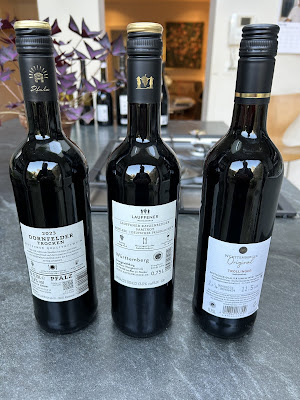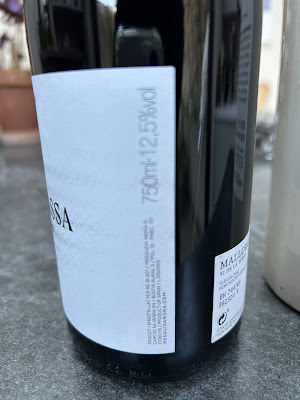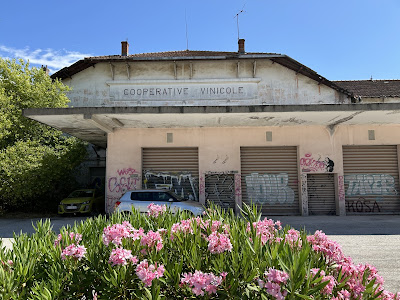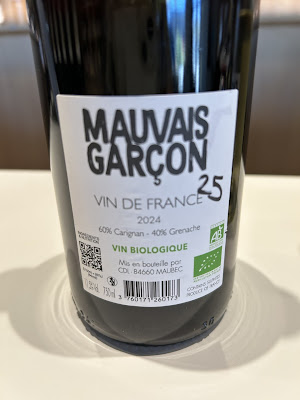Is the world shrinking in terms of diversity? PostBrexit it seems we don't get as varied a choice of wines as we used to. On the other hand consumers seem to be getting slowly more adventurous. What are we talking about? Take Swiss wine for a start. There ws a guy called Nick Dobson who between 2002 and 2012 used to import a large and fascinating range of Swiss wines. Switzerland is a hot-spot for rare grape varieties and Nick wasn't afraid to specialise in them.
The company was taken over by the redoubtable Joelle Nebbe-Mornod who has managed to keep it going until today. One has the impression that this has not been easy becuse Joelle has widened the range by including several non-Swiss wines (Beaujolais, Austria, Liechtenstein, Champagne) and if we are not mistaken, reduced the range if not the quantity of wines from Switzerland.
Not many other importers have taken up the challenge of bringing in Swiss wine so feeling the need to replenish our tiny stock of these fascinating wines we thought why not get a day flight to Basel on airmiles and bring back a haul of Himbertscha, Lafnetscha, Resi, Bondola, Completer, Diolinoir and Rauschling? Some of these are or have been available from Alpine Wines but many are no longer listed, out of stock or very expensive at up to £80 a bottle or more in certain cases.
So it made sense or so we thought to do a 'smash and grab' in Switzerland and we knew exactly where to go for that: the venerable Ullrich shop in Basel.
Spoiler alert: things have changed even more in Switzerland itself that at Alpine Wines. None of the varieties mentioned above was available from Ullrich. We were sure the choice had been much greater the last time we were there.
 |
| Humagne Rouge (Cornalin), Fendant and the rare Humagne Blanche |
In fact we were only able to buy a Humagne Rouge (aka. Cornalin), a Humagne Blanche (no relation) and of course a Fendant (Chasselas) there. The staff were very sweet but didn't know a great deal about Swiss grape varieties. Could something have changed there? There seemed to be an inordinate amount of Pinot Noir on the shelves. Later we read somewhere that Pinot Noir now accounts for 95% of Swiss red wine.
Also, there was not one bottle of Dole to be had. We had always been impressed by the range of Dole on offer at Zurich Airport Duty Free, but here at Ullrich, not a sign.
 |
| We actually bought this bottle of Dole when back in the UK |
 |
| Pleasant enough. |
Why did we want to buy a bottle of Dole you ask? It is a 50/50 blend of Pinot Noir and Gamay - a sort of Passetousgrains. Well, it is or was a Swiss speciality so we wanted to find out what it was that made it so. Ditto Chasselas which some say is a boring grape but it very much is a Swiss speciality so there had to be something to it.
 |
| 'Cepage Freiburger' |
 |
| Cave et Domaine du Petit Chateau |
 |
| 2023, 13.5%. Appellation d'Origine Controlle. |
Thanks to an article in 'Purple Pages' we had learend about a new Swiss hybrid called Freiburger. We managed to obtain a bottle of this from Moevenpick wine also in Basel . Apart from this bottle of Freiburger, the selection there was no better than at Ullrich.
Freiburger is also known as Freisamer and is a cross between Sylvaner and Pinot Gris.
Talking about Freiburger, our plan for the one day 'Smash and Grab' included a side-trip to Freiburg-im-Breisgau. This was to be a trip down memory lane hearkening back to 1963 when we spend a 'Sommersemester' brushing up our 'Germanistik' at the Albrecht Ludwigs Universitaet there. That was to have been our first deep immersion into a wine-producing area and we had enjoyed discovering the then little-known and unfashionable wines of Baden-Wuerttemberg and elsewhere.
 |
| Goethe |
We remember in particular consumeing refreshing bottles of Steinwein (a favourite of Goethe no less). Apparently Steiwein from Franken (Wuertzburg) is the oldest surviving wine in continuous production in Germany. It can be made from Riesling (inevitably) or Sylvaner.
We remember Sylvaner Steinwein in particular in ther 'Bocksbeutel,'
Also in the Freiburg Muensterplatz restaurants, you could get nice Baden wine in their characteristic glasses which are rare these days. These wines included the mysterious Rulander which we later discovered to be Pinot Gris or Pinot Grigio.
Back then people used to talk about Kaiserstuehler wines but we didn't drink any of those at that time. So we resolved to buy some Kaiserstuhl wines in Freiburg.
At the same time we put on the list some other German specialities otherwise unobtainable in the UK such as Trollinger (OK, that's Schiava which you can get here but not the German version),
 |
| Beethoven |
Portugieser, the grape of Voslau which we reckon is what Beethoven drank in Vienna when he couldn/t get his beloved Rheinland Hock, and Schwarzriesling (Pinot Meunier) and Samtrot (a clone of Pinot Meunier).
We also discovered a variety which was new to us; Rieslaner. This is a crossing of Riesling and Sylvaner from 1921 by August Ziegler at the Bayerischer Landesanstalt fuer Weinbau und Gartenbau in Veitshochheim near Wuertzburg. Rieslaner makes a white dessert wine and is usually rather expensive.
In Freiburg, we discovered a great wine merchant called Drexler. I was founded in 1899 but we had managed to miss it in 1963.
 |
| Dr. Heger Pinot Noir and Hoefflin's Souvignier Gris |
 |
| both from the famous Kaiderstuhl area near Freiburg |
The excellent staff at Drexler found a Spaetburgunder from the Kaiserstuhl, Dr. Heger's Ihringer 2020 which just fitted the bill and from them we also bought a Souvignier Gris by Weingut Hoefflin of Boetzingen, also in the Kaiserstuhl which should be interesting.
Also in Freiburg we went to the local branch of the fantastic supermarket, REWE where they had wines from all corners of Germany and elsewhere.
 |
| Dornfelder, Samtrot and Trollinger |
 |
| Samtrot is unheard-of and Trollinger is rare in the UK. |
Here we picked up a Samtrot and a Trollinger both from Wuerttemburg and a Dornfelder from the Pfalz.
While researching Kaiserstuhl wines we came across a merchant in Weil am Rhein, Germany just over the border from Basel called Wein Werte. This excellent company is the brainchild of an extraordinary New-Zealander, Dr. Craig Thorrold. As well as winemerchant Craig has been a Sommelier in a Michelin starred restaurant in London, obtained a DPhil in Medieval Studies in Cambridge and lectured in languages and culture at universities of applied sciences in the Netherlands, Germany, Austria and Switzerland. He is also part-owner of a restaurant for refugees near Basel SBB station called 'Restaurant du Coeur' and last but not least wine merchant.


On Wein Werte's list we had spotted many interesting wines including two we vere particularly keen to acquire: Heinrich's Roter Traminer 'Traminer Freyheit' an Orange wine from the Burgenland, Austria which we had throughly enjoyed previously and a true rarity of all rarities, a Mallorquin wine made by Mesquida Mora from a grape called Gorgollasa near Porreres, Mallorca.
 |
| It says 12.5%. |
Apparently at the turn of the 21st century there were only 4 vines left of Gorgollasa. These were cultivated by a group of passionare winemakers and in 2011 it became authorised in the Balearic islands. Today there are aroung 5 ha. and winemakers including Can Ribas, Oliver Moragues, Can Majoral, Selva Vins and our friend Galmes i Ribot (Cati Ribot) as well as Mesquida Mora are making wines with Gorgollasa.
Due to our impractical schedule we asked Craig Thorrold if we could pick up these two bottles from his restaurant in Basel since it lies alonside the very station we were useing to get to and from Freiburg. Not only did he agree to meet us there and hand over the bottles we had bought from Wein Werte online but he very kindly led us to the exact station platform for our train to Freiburg which thanks to him we caught with minutes to spare. You sometimes meet the most wonderful people in the wine world.
At the end of the day having checked in our 11 bottles, we took a look at Basel EuroAirport Duty Free. As in the city, things there had gone downhill over the years we were last there. In those days you could get a Gamaret/Garanoir among other Swiss wines there. Nowadays, nothing so interesting.









.jpg)





















































